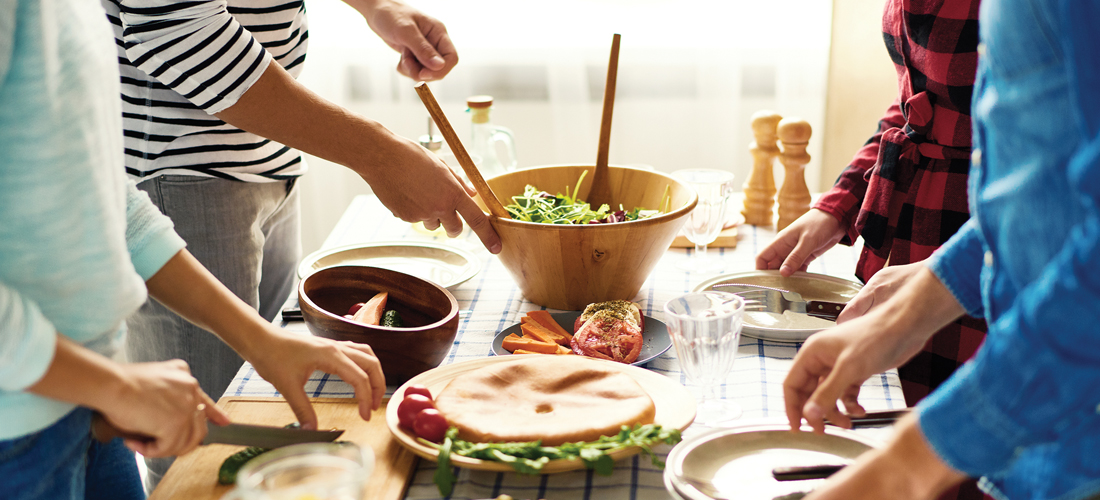
Family Dinners
The more they change over time, the more we need them
By Susan S. Kelly
Sure, sure, it’s turkey time, but how about the other 364 dinners someone needs to dream up, whip up, order up, serve up, and clean up for the hungry hordes? It’s been said that every family has a 10-meal rotation that they unconsciously stick to. Chicken, pork chops, spaghetti. Tacos, brats, pasta. Then it’s leftover night, or pizza night, and the rotation begins again.
In direct opposition to this menu stasis theory is the fact that, like everything else on the planet, family dinners change and evolve. At first, they’re wild, untamed things, with high chairs and thrown food. In time, bibs are replaced with napkins, and manners. The toddler turns 6, and learns to set the table. Actual conversation takes place during a family dinner, unless you make the mistake of asking a 7-year-old about the movie he saw, because a 7-year-old’s synopsis tends to last through dessert.
Then comes school. School, school, school. Tired of hearing about school, my mother decided to select a topic for discussion during our family dinners. “Tonight we’re going to talk about art,” she said one memorable table time. Muteness ensued. Cornbread was consumed. The experiment was an abject failure. Family dinners cannot bear that burden. Like nature itself, they have to wander all over the place and sprout in different directions. Also like nature, there’s an exception to every absolute: My children had friends whose parents, over Sunday dinner, would pay their kids a dollar if they could summarize the sermon at church. Their dinner table topic stayed on point. My sister handled the nightly kitchen table convos by asking everyone what the worst and best parts of their day had been. Her husband’s answer never varied: worst — getting out of bed; best — getting into bed.
Every family dinner has its accoutrements other than food. On television shows, families had sodas at dinner; only milk was served at our table. I longed for a spinning lazy Susan in the center of the table, bearing ketchup and Texas Pete bottles on its swiftly appointed rounds. I’d have settled for an upright napkin holder, so you could fish another out when yours fell out of your lap, or got sticky or shredded — a yearning that probably explains why I tend toward cloth napkins now for family dinners. Still, I hid those cloth ones away one Christmas so we could use holiday-themed ones, and didn’t find them until the following September. And still, family dinners had proceeded right on, with the one-ply paper ones.
Happy is the day when evolution gets ’round to when children can cook, rather than complain, about the unfamiliar vegetable, or the texture of the meatloaf. Then, each family member can “take a night” on a vacation, or a Wednesday. They delightedly pick the menu, proceed to shop, prepare, serve and wash up, while you contentedly enjoy the sunset, or the news. As long as you’re also content to foot the bill for tenderloin filets, or dine cheerfully on boiled hot dogs. A new era of family dinners is ushered in when girlfriends and boyfriends arrive on the scene. No more dishing out from pots and pans on the stovetop; time to up the game and make an impression with actual serving dishes. Flowers in a vase. Not candlelight, though: too much of a statement. Where there once was a clamor over who gets to say the blessing grows the nervousness of who gets picked to say the blessing.
Every family experiences years when organizing a dinner together centers around sports, meetings, babysitting and jobs, a task on a par with planning the invasion of Normandy. I wrote a novel whose plot included a family member who’d died unexpectedly. Of the grief-stricken moments of daily minutiae that followed, the most sorrowful was the evening the mother opened a kitchen drawer and gazed at the placemats. She realized that the rotating stack of four — checkered, straw, quilted — would now resume as three. The pattern of family dinners had been forever altered, hammered home by a detail as devastatingly simple as a pattern of placemats. Still, families consist of only two, too. My husband and I light candles every night. After 60, low lights are beneficial. Even the food looks better.
Fifty in a field for a reunion, four for chicken tetrazzini, a pair on stools at the counter with a bowl of soup. Breakfast for dinner. The Sunday steak. Take-out. A USPS delivery from a specialty service with every ingredient, plus recipes, included. Or just the specialty of the house — one of those 10 meals. In the end, only three ingredients truly define a family dinner: Food. Conversation. People. OH
Susan Kelly is a blithe spirit, author of several novels, and proud grandmother.





